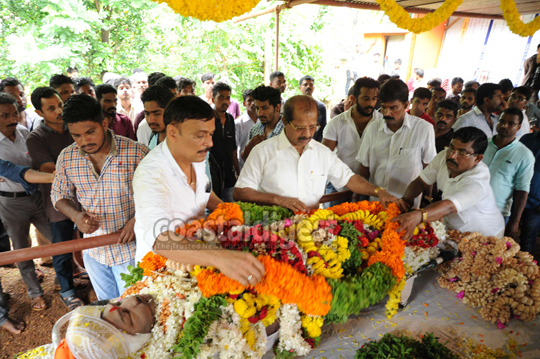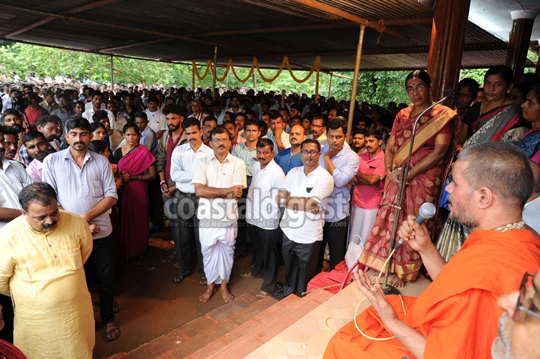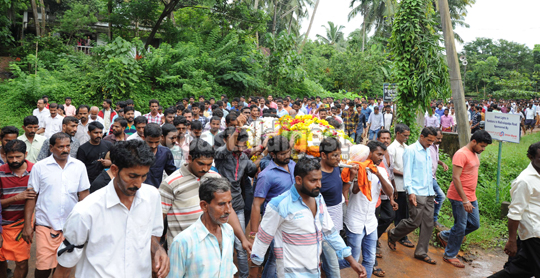Mangaluru, Jul 8: Thousands of grief-stricken men and women, most of them activists of Sangh Parivar on Saturday bid a tearful adieu to Sharath Madivala, a 28-year-old RSS activist, who breathed his last at a hospital in Mangaluru last night after losing his three-day long fight for life.

The mortal remains of Sharath was taken from Mangaluru to his home town, Sajipa Munnur, in Bantwal taluk in a procession by thousands of Hindutva activists in spite of the enforcement of the prohibitory orders under Section 144 of Criminal Procedure Code across the district.
The procession caused chaos in BC Road, wherein some miscreants pelted stones at shops and vehicles belonging to a minority community. However, police managed to bring the situation under control by resorting to minor baton charge.
Tribute by Kalladka Bhat
In spite of the opposition by police, the mortal remains were kept for public viewing for a few minutes in front of the ‘Udaya Laundry’ in BC Road where Sharath was stabbed by the three unidentified miscreants on July 4.
Tears rolled down the eyes of RSS stalwart Prabhakar Bhat and his wife when they entered the ambulance and paid floral tribute to the mortal remains of the young and innocent ‘karyakarta’ of the Sangh. The mourners, who had gathered on both sides of the road too paid an emotional tribute to the departed soul by repeatedly chanting ‘Sharath Amar Rahe’.
Final rites
The funeral rites of Sharath took place at a garden located in front of his house at Kandur in Sajipa Munnur after an hour-long public viewing in the village. Thaniyappa Madivala, the victim’s father, lit the pyre in the presence of thousands of mourners and Sangh Parivar leaders.
After the cremation, a mourning meet was also held in the village. RSS leader Na Seetharam, speaking on the occasion urged the people not to lose their patience and to face the situation bravely. He said that society needed thousands of ‘patriots’ like Sharath.
Father breaks silence
A shell-shocked father blamed his own fate while expressing anger towards the government, which according to him failed to catch the real culprits.
“This is my bad luck. My son Sharath always helped me and tried to solve my problems. He was a hard worker. He never troubled anybody. People had a good opinion of him,” he said.
“The government is not capable of punishing the culprits. The killers will walk free within six months after their arrest,” he complained.
Also Read:
‘Activists’ caught on camera collecting stones during funeral procession
Funeral procession leads to chaos in BC Road; stones pelted at shops, vehicles
Bantwal remains on the edge as slain RSS worker’s body taken out in procession














Comments
ALhamdullillah... Thanks to God
Muslims are waking up and doing the right way and follow the teaching of true islam in helping the humanity. Thats the way all should follow.
Add new comment